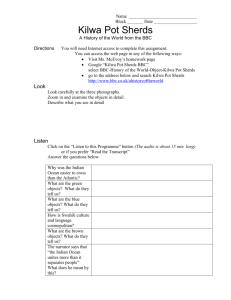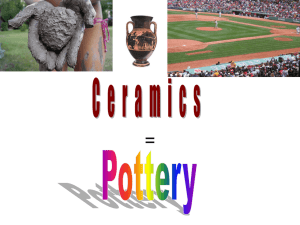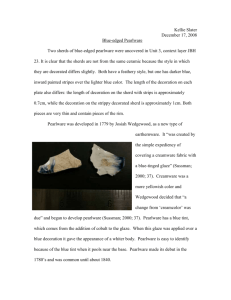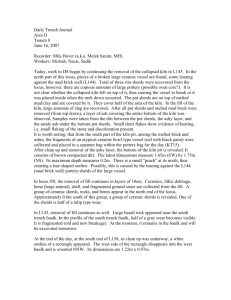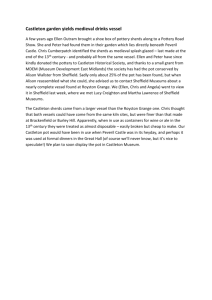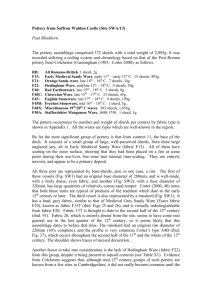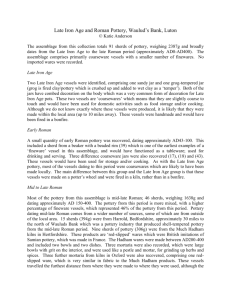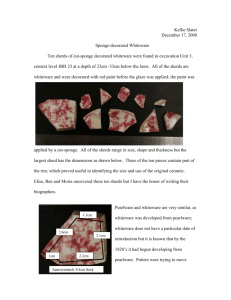Henry Road pottery report
advertisement
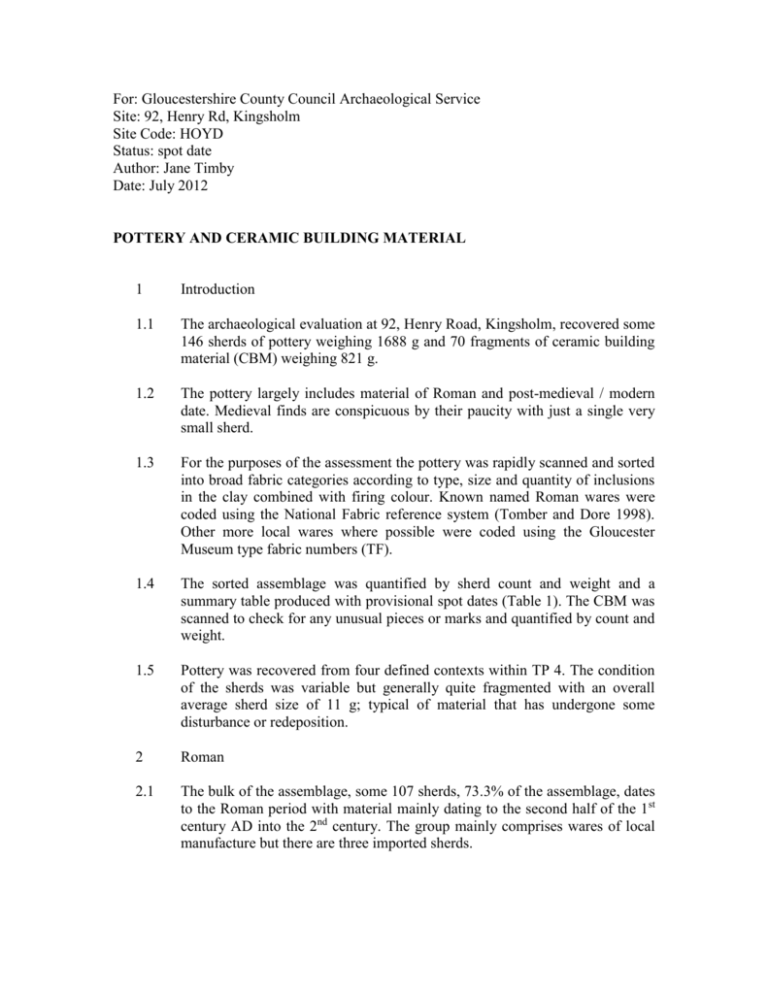
For: Gloucestershire County Council Archaeological Service Site: 92, Henry Rd, Kingsholm Site Code: HOYD Status: spot date Author: Jane Timby Date: July 2012 POTTERY AND CERAMIC BUILDING MATERIAL 1 Introduction 1.1 The archaeological evaluation at 92, Henry Road, Kingsholm, recovered some 146 sherds of pottery weighing 1688 g and 70 fragments of ceramic building material (CBM) weighing 821 g. 1.2 The pottery largely includes material of Roman and post-medieval / modern date. Medieval finds are conspicuous by their paucity with just a single very small sherd. 1.3 For the purposes of the assessment the pottery was rapidly scanned and sorted into broad fabric categories according to type, size and quantity of inclusions in the clay combined with firing colour. Known named Roman wares were coded using the National Fabric reference system (Tomber and Dore 1998). Other more local wares where possible were coded using the Gloucester Museum type fabric numbers (TF). 1.4 The sorted assemblage was quantified by sherd count and weight and a summary table produced with provisional spot dates (Table 1). The CBM was scanned to check for any unusual pieces or marks and quantified by count and weight. 1.5 Pottery was recovered from four defined contexts within TP 4. The condition of the sherds was variable but generally quite fragmented with an overall average sherd size of 11 g; typical of material that has undergone some disturbance or redeposition. 2 Roman 2.1 The bulk of the assemblage, some 107 sherds, 73.3% of the assemblage, dates to the Roman period with material mainly dating to the second half of the 1st century AD into the 2nd century. The group mainly comprises wares of local manufacture but there are three imported sherds. 2.2 The imports include two sherds of Baetican olive-oil amphorae from Southern Spain (code BAT AM) and one tiny fragment of South Gaulish samian (code LGF SA). The latter is likely to date to the 1st century AD. 2.3 The remaining assemblage comprises wares of local origin and these can be split into wares specifically associated with Kingsholm; wares typical of the Gloucester City kilns and Severn Valley ware from the local area. 2.4 The Kingsholm wares include five sherds of oxidised sandy ware (Glos TF 36), probably flagon dating to the Neronian period. Also present are several sherds of a black, micaceous ware, a variant of the local TF 11A fabric from contexts (402) and (404). The sherds come from a jar or beaker with rusticated decoration which is very typical of the vessels made at the kiln(s) under the Rugby Ground and is likely to date sometime within the Flavio-Trajanic period (later 1st-early 2nd century). 2.5 Most of the Roman sherds are in fabrics TF 11a (oxidised or grey, slightly micaceous wares) with single pieces of TF 7, a white-slipped variant of TF11A and TF3A, a mica-slipped variant. All these are likely to date within the Flavio-Trajanic period. The TF 3A sherd is decorated with small raised flattened discs and is probably from a beaker or small jar. 2.6 There are few featured sherds but there are 29 sherds, probably from the same vessel, a jar with a carinated shoulder from (402). This could be a vessel disturbed from a burial. 2.7 Also of note is the base of a grey ware jar from (404) which has been modified after firing. A large hole has been drilled through the centre for some unknown secondary purpose. 2.8 There are 32 sherds present of the local oxidised Severn Valley ware (SVE OX; Glos TF 11B). This is a long lived industry and unfeatured sherds are difficult to date but there are two sherds which are early variants (Glos TF 11D) and typical of the 1st century AD. 3 Medieval 3.1 A single very small sherd of oolitic-limestone tempered cooking pot / jar was present in context (400). This is typical of pottery found in Gloucester from the early medieval period and may have been made in the Haresfield area. 4 Post-medieval 4.1 The remaining 38 sherds found all date to the post-medieval / modern periods and are very typical of the range of finds found in Gloucester. Wares of note include North Devon gravel-tempered ware imported from the 17th century onwards, Herefordshire Border ware, black iron-glazed earthenware from possible Bristol or Staffordshire, English and German stone-wares, tin-glazed ware and various glazed and unglazed red earthenware which were made at a variety of local sources. Overall the wares appear to span the 17th through to the 19th century. 5 Ceramic building material 5.1 Some 70 fragments of ceramic building material (CBM) were recovered with the pottery. The pieces were exceptionally fragmented making any identification difficult. Where it could be determined it appears to largely post-Roman in date but there were a few pieces which could potentially be from Roman roofing tile (tegulae and imbrices). 6 Stratigraphy 6.1 The uppermost horizon (400) produced some 23 sherds of pottery and 28 fragments of CBM. Apart from the one small sherd of medieval date all the finds date to the later post-medieval period. 6.2 Context (401) produced some 21 sherds of pottery and 30 fragments of CBM. This pottery assemblage comprised 13 sherds of post-medieval date and eight Roman sherds. The Roman is residual in a later post-medieval level which probably dates to the 18-19th century. 6.3 Context (402) produced 84 sherds and 12 fragments of CBM. With the exception of three post-medieval sherds the pottery is all Roman in date. The CBM could all be Roman but the pieces are small. It is possible that the three later sherds are intrusive from the upper level but the bulk of the pottery suggests a later 1st-early 2nd century date. 6.4 Context (404) produced 18 sherds of Roman pottery and no CBM. The pottery reflects the same date as (402) and indeed there are possible some sherds from the same vessel in each.
